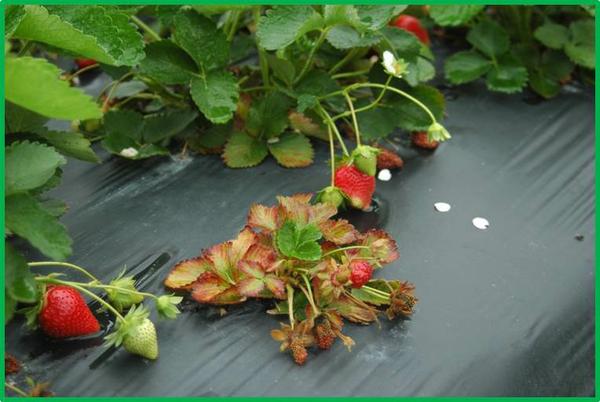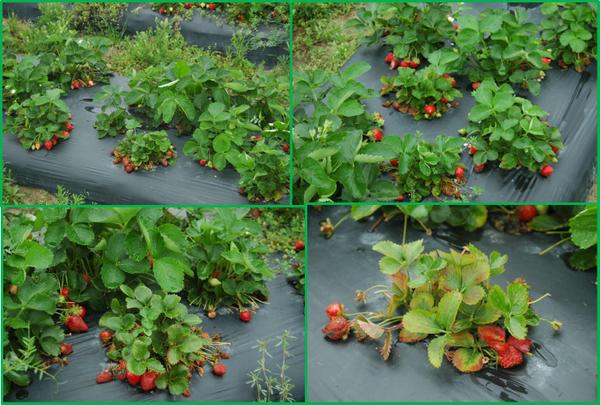Introduction
In most years, viruses are not a major problem in annual production systems or in nursery operations. However, a low incidence may occur from year to year. In some cases, individual virus strains may not pose an economic problem but when two or more viruses combine then severe plant effects may occur.
Symptoms and Signs
Virus plants remain stunted and the stunting is apparent soon after transplanting in annual production systems. Depending on the virus, leaves will become discolored and plants take on a compact appearance. For example, in 2004 Sweet Charlie plants had a concerning incidence Strawberry Mild Yellow Edge virus (SMYEV; Figure SS-1, Figure-SS-2). In 2013, there was widespread distribution of virus infected plants and information is available about the episode. This problem was associated with the co-infection of SMYEV and Strawberry Mottle Virus (SMoV). These viruses are transmitted by specific aphids and additional information on these two is provided below. Likewise, in another year, several plants were positively identified with Raspberry Ringspot Virus (RRSV; Figure SS-3) although symptoms can vary with the strain. RRSV is transmitted by nematodes (Longidorus sp.).
Management
Virus management is critical for the industry as a whole and in nurseries. This is accomplished through tissue culture methods to propagate virus-free plants and using virus indexing methods to ensure they remain virus free. This must be complemented by strict protocols in plant propagation methods such as use of screened houses to exclude vectors and isolation of nursery plants from fruiting fields. These protocols are well documented. In fruiting fields, it is important to get a sure diagnosis if virus problems are suspected and if there are sufficient plants to be concerned about. In most cases, the incidence level has been low and the problem does not persist from one year to the next. Therefore, no action is needed. It does not pay to cull plants since the viruses are not known to spread in the fruiting field. If many plants are affected and if plants are mildly infected, every effort to optimize growth through fertility, water use and other practices is helpful. Once a diagnosis is made additional information on the specific virus or virus complex is available.
Pathogen
Strawberry mild yellow edge virus (SMYEV) is an aphid-borne potexvirus with flexuous particles measuring ~482 nm long and a single stranded RNA genome. When SMYEV is the only virus infecting a strawberry plant, there are no visual symptoms. However, when a plant is infected by SMYEV and an additional virus or viruses (referred to as a virus-complex), the plant may express symptoms such as stunted, twisted or deformed leaves, generalized chlorosis of the leaves and reduced plant vigor. A second virus, probably a luteovirus, is likely to be involved in conjunction with SMYEV, acting as a helper virus that provides aphid transmission in the field.
Strawberry mottle virus (SMoV) is an aphid-borne virus with isometric hexagonal particles, approximately 28 nm in diameter, and a bipartite genome consisting of two single-stranded RNAs (Thompson et al., 2002). SMoV is the most common and widespread virus of strawberry worldwide. Numerous strains of SMoV exist, and most are symptomless in strawberry cultivars, but severe strains may reduce vigor and yield by up to 30%. In mixed infections with, for example, Strawberry crinkle virus (SCV), Strawberry vein banding virus (SVBV) and/or Strawberry mild yellow edge virus (SMYEV) symptoms can be very damaging (Martin, 2006). SMoV is vectored in a semipersistent manner by aphids in the genus Chaetosiphon and by Aphis gossypii.
Diagnostic Procedures
SMYEV has a single-stranded positive-sense RNA genome containing 5,966 nucleotides and can be detected readily by reverse transcription-polymerase chain reaction (RT-PCR) or ELISA (Thompson et al., 2003). Commercial ELISA tests for SMYEV are available from Agdia and AC Diagnostics.
RT-PCR can be used to detect SMoV using a pair of primers developed by Thompson and Jelkmann based on a conserved nucleotide sequence in the 3′ non-coding region (2003). The nucleic acid extraction and RT-PCR procedures of Thompson and Jelkmann should be followed to ensure a robust and reliable detection method (2003).
References
Martin, R. R., and Spiegel, S. 1998. Strawberry Mild Yellow Edge Virus. Pp. 64 in: Compendium of Strawberry Diseases, 2nd edition, Maas, J. L. (edt.). APS Press. St. Paul, MN.
Martin, R. R., and Spiegel, S. 1998. Strawberry Mottle Virus. Pp. 66-67 in: Compendium of Strawberry Diseases, 2nd edition, Maas, J. L. (edt.). APS Press. St. Paul, MN.
Martin, R. R., and Tzanetakis, I. E. 2006. Characterization and recent advances in detection of strawberry viruses. Plant Dis. 90:384–396.
Thompson, J. R., Leone, G., Lindner, J. L., Jelkmann, W., and Schoen, C. D. 2002. Characterization and complete nucleotide sequence of Strawberry mottle virus: A tentative member of a new family of bipartite plant picorna-like viruses. J. Gen. Virol. 83:229-239.
Thompson, J. R., and Jelkmann, W. 2003. The detection and variation of Strawberry mottle virus. Plant Dis. 87:385-390.
Thompson, J. R., Wetzel, S., Klerks, M. M., Vašková, D., Schoen, C. D., Špak, J., and Jelkmann, W. 2003. Multiplex detection of four aphid-borne viruses in Fragaria spp. in combination with a plant mRNA specific internal control. J. Virol. Methods 111:85-95.
Publication date: July 24, 2014
Reviewed/Revised: July 26, 2024
N.C. Cooperative Extension prohibits discrimination and harassment regardless of age, color, disability, family and marital status, gender identity, national origin, political beliefs, race, religion, sex (including pregnancy), sexual orientation and veteran status.



